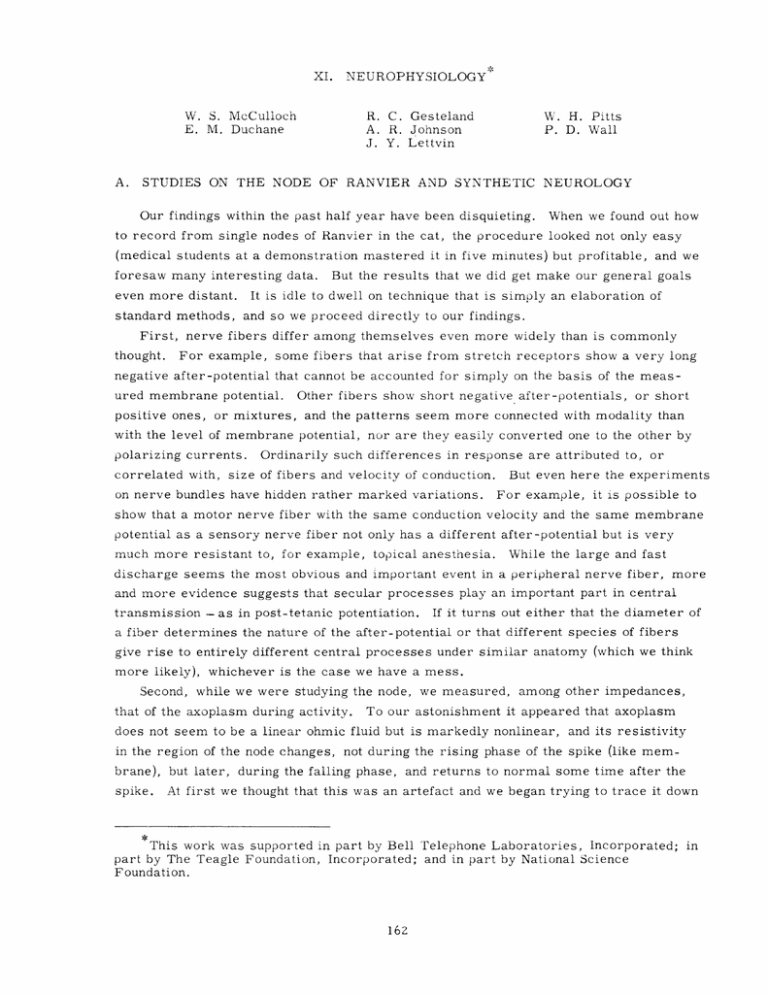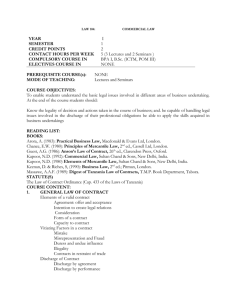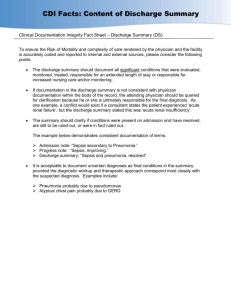XI. NEUROPHYSIOLOGY
advertisement

XI. W. S. McCulloch E. M. Duchane A. NEUROPHYSIOLOGY R. C. Gesteland A. R. Johnson J. Y. Lettvin W. H. Pitts P. D. Wall STUDIES ON THE NODE OF RANVIER AND SYNTHETIC NEUROLOGY Our findings within the past half year have been disquieting. When we found out how to record from single nodes of Ranvier in the cat, the procedure looked not only easy (medical students at a demonstration mastered it in five minutes) but profitable, and we foresaw many interesting data. even more distant. But the results that we did get make our general goals It is idle to dwell on technique that is simply an elaboration of standard methods, and so we proceed directly to our findings. First, nerve fibers differ among themselves even more widely than is commonly thought. For example, some fibers that arise from stretch receptors show a very long negative after-potential that cannot be accounted for simply on the basis of the measured membrane potential. Other fibers show short negative after-potentials, or short positive ones, or mixtures, and the patterns seem more connected with modality than with the level of membrane potential, nor are they easily converted one to the other by polarizing currents. Ordinarily such differences in response are attributed to, or correlated with, size of fibers and velocity of conduction. on nerve bundles have hidden rather marked variations. But even here the experiments For example, it is possible to show that a motor nerve fiber with the same conduction velocity and the same membrane potential as a sensory nerve fiber not only has a different after-potential but is very much more resistant to, for example, topical anesthesia. While the large and fast discharge seems the most obvious and important event in a peripheral nerve fiber, more and more evidence suggests that secular processes play an important part in central transmission - as in post-tetanic potentiation. If it turns out either that the diameter of a fiber determines the nature of the after-potential or that different species of fibers give rise to entirely different central processes under similar anatomy (which we think more likely), whichever is the case we have a mess. Second, while we were studying the node, we measured, among other impedances, that of the axoplasm during activity. To our astonishment it appeared that axoplasm does not seem to be a linear ohmic fluid but is markedly nonlinear, and its resistivity in the region of the node changes, not during the rising phase of the spike (like membrane), but later, during the falling phase, and returns to normal some time after the spike. At first we thought that this was an artefact and we began trying to trace it down This work was supported in part by Bell Telephone Laboratories, Incorporated; in part by The Teagle Foundation, Incorporated; and in part by National Science Foundation. 162 NEUROPHYSIOLOGY) (XI. when Dr. Strickholm, from Minnesota, came by with exactly similar results on muscle where the sources of trouble we were attacking were obviated. At the same time John Segal in Dr. Jenerick's laboratory, M. I. T. , showed the myoplasm to be probably severely nonlinear in dc measure of resistance. Finally, with Prof. M. Minsky, we built some artificial neurons for the artificial The output of each neuron was a fixed freintelligence project at Lincoln Laboratory. There were two quency of pulses at rest - and could be set to any arbitrary frequency. inputs per neurun (high impedance points); one raised the rate of firing on receiving Each pulses from another neuron, the other lowered the rate - excitation and inhibition. It was very amusing neuron could excite or inhibit itself with output connected to input. to discover that whereas one could easily synthesize arbitrary patterns of firing in three or four interconnected neurons, the devices were interconnected. one could not, from looking at the patterns, state how Of course, we all knew this from a priori considera- tions - rather well digested by now - but it was quite startling to be confronted with the point in actual operation. So comes doom to the hope of abstracting pattern of connec- tion from pattern of single unit discharge. ELECTROMETER CATHODE FOLLOWER B. WVhen the 1 K Figure XI-1 illustrates a circuit that is now in use in our laboratory. variable resistance is adjusted so that the collector of T 2 sits at approximately -3. volts, the variational resistance of the emitter load circuit of T 1 is 5 greater than 1 megohm at approximately 3 ma. Thus the cathode current of 5886 (electrometer tube) t i s_ kent V 23.5 nnrnorimatelv amn. At the col- lector of T 2 there is an inphase gain slightly greater than 2 with respect to any signal at the emitter of T . This gain-of-two point supplies the positive feedback (via the emitter follower T 3 ) through the condenser to the grid of 5886 to neutralize shunt capacitance 0 at the input, and also, when divided by the pair of 10-K resistances, the unity gain feedback from cathode to screen of 5886. Thus the electrometer tube is bootstrapped over a reasonable dynamic range (approxV imately 4 volts). Fig. XI-1. Circuit for electrometer cathode follower. Specifications are as fou- lows: l I 163 g < 1 x 1013 amp. (XI. NEUROPHYSIOLOGY) Frequency response with a 1-inch 20-megohm series resistor to the grid of 58836, flat to 40 kc, after suitable adjustment of C. Output; approximately 0. 6 V+ with respect to input; drift, approximately 20-30 microvolts/minute, and less if the circuit is embedded in a silicone 550 bath. C. REPETITIVE FIRING OF NEURONS Two types of repetitive firing have been examined. The first is the echo phenomenon called the dorsal root reflex which occurs in spinal afferent fibers. The second is the repetitive firing of the sensory nerve cells in the spinal cord after the arrival of a volley of sensory nerve impulses. A paper on this subject, which will be published in the Journal of Neurophysiology, can be summarized as follows. The pattern of repetitive discharge of the dorsal root reflex and of sensory interneurons in the unanesthetized cat spinal cord has been examined by microelectrodes and a new method of recording. 1. The dorsal root reflex was set off by stimulation of peripheral nerves. The initial latency and the variation of latency throughout the discharge depended on the nerve stimulated and the strength of stimulation. The pattern of the response differed markedly from that seen in the interneurons. 2. The time of arrival of the afferent impulse in an afferent fiber did not affect the pattern of the dorsal root reflex. 3. The interjection of an impulse into a dorsal root reflex resets the rhythm, and it is concluded that the site of origin of the rhythm is within the fiber. 4. "Spontaneous" activity of sensory endings is similarly reset by the introduction of an additional impulse. 5. The pattern of discharge of the sensory interneurons varied between three types of response: a low-frequency short discharge with great variation of latency, a highfrequency prolonged discharge, and a short abrupt discharge. 6. The interjection of an additional impulse into the repetitive discharge of an interneuron fails to reset the rhythm and we conclude that the repetitive firing is probably driven by bombardment from other neurons. 7. The "spontaneous" activity of the interneurons is not reset by interjected impulses. In subsequent work on this problem we have examined the variability of the pattern of discharge. In the case of the dorsal root reflex, the answer is clear-cut. The frequency of the discharge is unaffected by the number of impulses in the afferent volley; but the larger the volley, the smaller the variability in the pattern of discharge of the dorsal root reflex. However, when the discharge of the postsynaptic cells is examined this simple situation is no longer found, and an increase in size of the input volley 164 (XI. NEUROPHYSIOLOGY) frequently results in an increase in the variability of the output pattern. The work on the behavior of the sensory internuncials is being continued in an attempt to relate the pattern of discharge to the nature and position of a touch stimulus to the skin. D. THE ROLE OF REFLEXES IN MOVEMENT A. R. Johnson has started experiments to determine the manner in which the neuromuscular reflexes play a part in the maintenance of position against a varying pressure or in the maintenance of a steady pressure against a varying position. In the fi-rst stage of this experiment, J. V. Cichon completed studies on the variation of tension in a single muscle while the muscle was being forced to stretch and relax at various frequencies. The results showed that reflex adjustment continues to play a part when oscillations up to 25 cps are impressed on the muscle. Highly characteristic patterns of response were seen at various frequencies. studied. The effect of drugs on this reaction was The results of this first stage were described in Mr. Cichon's undergraduate thesis for the Department of Physics. 165







